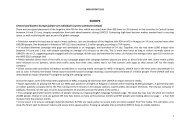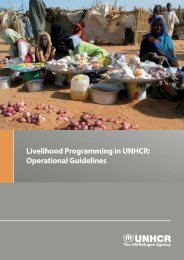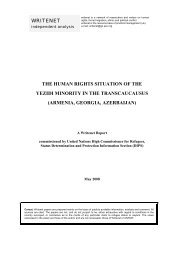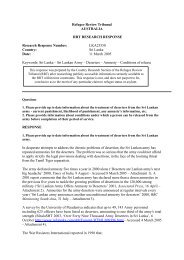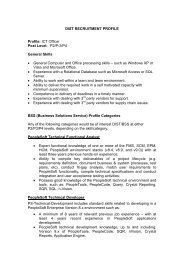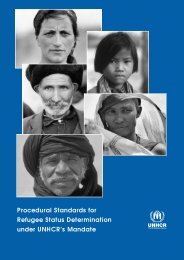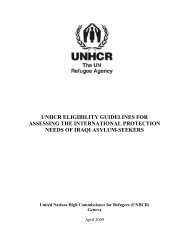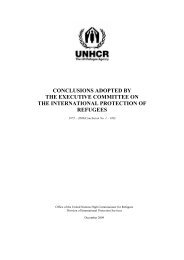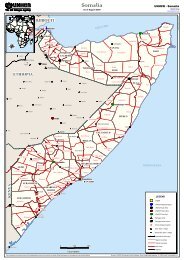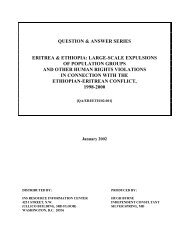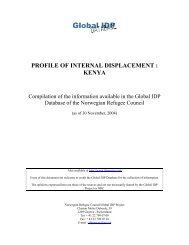UNHCR's ELIGIBILITY GUIDELINES FOR ASSESSING THE ...
UNHCR's ELIGIBILITY GUIDELINES FOR ASSESSING THE ...
UNHCR's ELIGIBILITY GUIDELINES FOR ASSESSING THE ...
Create successful ePaper yourself
Turn your PDF publications into a flip-book with our unique Google optimized e-Paper software.
III. MAIN GROUPS PRACTICING VIOLENCE<br />
A. General<br />
While non-state actors were identified as the main groups violating human rights and<br />
international humanitarian law, when UNHCR’s issued its Guidelines Relating to the<br />
Eligibility of Iraqi Asylum-seekers 69 in October 2005, increasingly state actors have come<br />
to the forefront, including members of the ISF. Furthermore, with the escalation of<br />
sectarian violence since 2006, armed militias have not only filled the security vacuum in<br />
the country, but have also become responsible for targeted attacks and displacement.<br />
Militias are linked to major Shi’ite political parties and personalities such as the Supreme<br />
Council for the Islamic Revolution in Iraq (SCIRI) and Muqtada Al-Sadr, 70 and have<br />
infiltrated the Shi’ite-dominated law enforcement agencies or closely collaborate with<br />
them. In addition, criminal groups have also become involved in human rights violations<br />
targeting individuals of specific profile.<br />
In many cases, it will prove difficult, if not impossible, for victims to identify who harmed<br />
them or why they were targeted. Perpetrators of violence often remain unidentified for<br />
a number of reasons, such as the failure or inability of the State to undertake criminal<br />
investigation or the sheer number of actors actively engaged in violent activities in today’s<br />
Iraq. Although they have diverse agendas, these actors often share common targets, e.g.<br />
members of religious minorities or certain professions.<br />
B. Lack of National Protection<br />
Pervasive violence, institutional weaknesses, and a general lack of rule of law seriously<br />
impede the ability of Iraqi authorities to provide protection to its citizens. The ISF is itself<br />
a major target of the insurgency 71 and has been infiltrated by, or has collaborated with,<br />
armed groups practicing violence. The ISF also reportedly lacks leadership, training,<br />
equipment and personnel and continues to be highly dependent on the support of the<br />
MNF. 72<br />
69<br />
See above footnote 8.<br />
70<br />
For an overview of these Shi’ite militias, see: UNHCR, UNHCR, 2005 Country of Origin Information<br />
Iraq, p. 59 and further, see above footnote 53.<br />
71<br />
On 24 December 2006, Jawad Al-Bolani, the Iraqi Minister of Interior, indicated that 12,000 police<br />
officers had been killed since 2003, an average of ten police officers every day. See: BBC News, Iraqi police<br />
deaths “hit 12,000”, 24 December 2006, http://news.bbc.co.uk/2/hi/middle_east/6208331.stm.<br />
72<br />
UNAMI HRO assessed that “(L)aw enforcement agencies are insufficient, inadequately equipped and in<br />
need of further training”; see UNAMI HRO, August 2006 Human Rights Report, p. 1, see above footnote 26.<br />
According to the CRS, “President Bush tacitly acknowledged the lack of capability of the ISF by announcing<br />
that “we will increase the embedding of American advisers in Iraqi Army units and partner a Coalition<br />
brigade with every Iraqi Army division””; see: The Library of Congress, Congressional Research Service, The<br />
Iraqi Security Forces: The Challenge of Sectarian and Ethnic Influences, CRS Report for Congress,<br />
18 January 2007, p. 3, http://fpc.state.gov/documents/organization/79272.pdf. See also Iraq Study Group<br />
Report, p. 12-14, see above footnote 35.<br />
35




